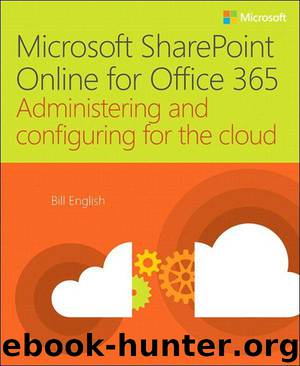Microsoft SharePoint Online for Office 365: Administering and configuring for the cloud (Vivek Sahu's Library) by Bill English

Author:Bill English
Language: eng
Format: mobi
Publisher: Microsoft Press
Published: 2015-12-13T16:00:00+00:00
Chapter 6. Configuring search
Relevance, precision, and recall
Analytics processing
Managing the search schema
Search Navigation web parts
Changing the display name or the URL of a search vertical
Search Refinement web part
Basic Search Center information
Summary
In a very real sense, the last two chapters on the term store and records management focused on the portability side of the information-management equation. Both chapters dealt with how to input information into Microsoft SharePoint Online and how to organize it. Entire books could be written on those two topics. In fact, hundreds of books have been written on them.
So when we come to search, we’re really talking about the findability aspect of information management. If information goes into an information-retrieval system, it needs to come out. And search is the main way you pull information out of the information-retrieval system. This makes search a very important topic for you, the system administrator of a SharePoint Online environment. Users are going to put information into SharePoint Online, and naturally they will want to pull it back out quickly and easily.
You can do a lot right in your SharePoint Online implementation and it might still fail if you don’t figure out how to help people get information out of SharePoint Online in the form and manner that they need to support their daily job duties. Unfortunately, search is often viewed as an application-specific solution for findability. Scores of companies believe that if they just have enough Google boxes or search servers they’ll be able to find the information that they want, when they want it. The problem is that search focuses on matching keywords with the content. Many companies assume that if their users have the right keyword, they can match that keyword correctly to the content item they need. But generating syntactically correct result sets is only a part of what search is about in SharePoint Online.
What most people don’t realize is that as the size of the corpus grows, the ability to find the right document using a simple keyword search diminishes. Research based on analyzing large bodies of text shows that the two words we use most frequently in the American version of the English language account for 10 percent of all the words we use. Moreover, 50 words account for 50 percent of all the words we use. And because people tend to use the same word to mean different things instead of learning new words, which would be more difficult, the meaning of many words becomes more diverse and generalized over time. Hence, language naturally trends toward the use of fewer words to refer to a wider range of concepts, objects, and elements, with the range of meanings becoming both more diverse and disparate.
Let me illustrate this. A word as simple as “horn” can have vastly different meanings: a car horn, a musical instrument, or the horn on an animal, such as a ram. So, is it a horn, horn, or horn? Is it resume or resumé? As you can see in the English language, we use the same word to refer to vastly different things.
Download
This site does not store any files on its server. We only index and link to content provided by other sites. Please contact the content providers to delete copyright contents if any and email us, we'll remove relevant links or contents immediately.
Sass and Compass in Action by Wynn Netherland Nathan Weizenbaum Chris Eppstein Brandon Mathis(7402)
Grails in Action by Glen Smith Peter Ledbrook(7296)
Kotlin in Action by Dmitry Jemerov(4638)
Management Strategies for the Cloud Revolution: How Cloud Computing Is Transforming Business and Why You Can't Afford to Be Left Behind by Charles Babcock(4131)
The Age of Surveillance Capitalism by Shoshana Zuboff(3423)
Learn Windows PowerShell in a Month of Lunches by Don Jones(3242)
Mastering Azure Security by Mustafa Toroman and Tom Janetscheck(3027)
Mastering Python for Networking and Security by José Manuel Ortega(2951)
Blockchain Basics by Daniel Drescher(2891)
TCP IP by Todd Lammle(2640)
Microsoft 365 Identity and Services Exam Guide MS-100 by Aaron Guilmette(2612)
From CIA to APT: An Introduction to Cyber Security by Edward G. Amoroso & Matthew E. Amoroso(2483)
Hands-On Azure for Developers by Kamil Mrzyglod(2412)
Configuring Windows Server Hybrid Advanced Services Exam Ref AZ-801 by Chris Gill(2370)
React Native - Building Mobile Apps with JavaScript by Novick Vladimir(2340)
MCSA Windows Server 2016 Study Guide: Exam 70-740 by William Panek(2313)
The Social Psychology of Inequality by Unknown(2311)
The Art Of Deception by Kevin Mitnick(2298)
Azure Containers Explained by Wesley Haakman & Richard Hooper(2262)
